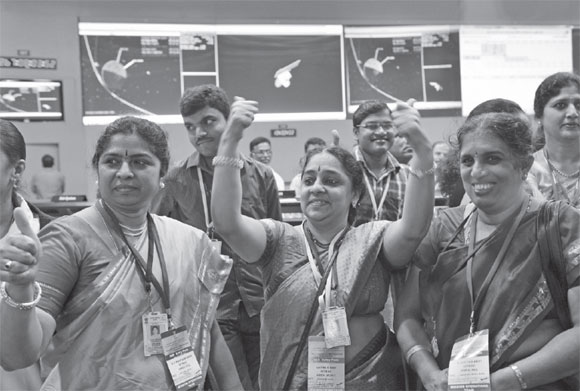Indian orbiter reaches Mars
Prime Minister Modi lauds scientists for reaching the red planet on first attempt
India's low-cost mission to Mars successfully entered the red planet's orbit on Wednesday, crowning what Prime Minister Narendra Modi said was a "near impossible" push to become the first country to succeed on its maiden attempt.
The Mars Orbiter Mission had a budget of $74 million, about one-tenth of what the US space agency NASA spent on sending its Maven spacecraft to Mars.
"History has been created today," said Modi, who burst into applause along with hundreds of scientists at the state-run Indian Space Research Organisation when it was announced the mission had been accomplished.
"We have dared to reach out into the unknown and have achieved the near impossible," said Modi, wearing a red waistcoat at the space command center in Bangalore.
India joins the United States, Russia and Europe in successfully sending probes to orbit or land on Mars. Apart from India, no country has managed to succeed on its first attempt.
The ISRO successfully ignited the main 440 Newton liquid engine and eight small thrusters that fired for 24 minutes and trimmed the speed of the craft to allow smooth orbit. Confirmation of orbit entry was received at around 8 am in India.

After completing the 666-million-km journey over more than 10 months, the spacecraft, called Mangalyaan - meaning Mars craft in Hindi - will now study the red planet's surface and scan its atmosphere for chemical methane. It will not land.
ISRO scientists will operate five scientific instruments on the spacecraft to gather data, the space agency's scientific secretary V. Koteswara Rao said.
The expected life of the craft is six months, after which it will run out of fuel and the agency will not be able to maintain its orbit.
Modi has said he wants to expand the country's space program. The technological triumph is well-timed for him - he will be able to tout the achievement on a trip to the United States starting on Friday.
Modi also wears the hat of India's minister of space. He endorsed the low cost of the project, saying it was even less than the budget for the Hollywood blockbuster movie Gravity, which was about $100 million.
NASA, which helped India with communications for its mission, congratulated the ISRO. The Mangalyaan craft and NASA's Maven, built at a cost of $671 million, are simultaneously orbiting the red planet.
India's space program was launched in the early 1960s. The country developed its own rocket technology after Western powers imposed sanctions for a nuclear weapons test in 1974.
Still, the country remains a small player in a global space industry that has grown to $314 billion in revenues and government budgets, according to the Space Foundation in Colorado.
Experts say successful Mars missions can help change that.
"ISRO will now hopefully attract a lot of business," said Mayank N. Vahia, a scientist at the Tata Institute of Fundamental Research. "We will now attract more international attention and international trade for satellites."
Two-thirds of the craft's parts were made by Indian companies, such as Larsen &Toubro and Godrej &Boyce.
With 30 Indian and 40 foreign satellite launches so far, its nearest cheap competition would be China, which has bigger space launchers. The ISRO signed an agreement with the China National Space Administration on Friday to cooperate in research and development of various satellites.
|
Staff members at the Indian Space Research Organisation celebrate at the ISRO Telemetry, Tracking and Command Network in Bangalore after the Mars Orbiter successfully enters orbit on Wednesday. India became the first nation to reach Mars on its maiden attempt. Manjunath Kiran / Agence France-Presse |
(China Daily 09/25/2014 page11)















